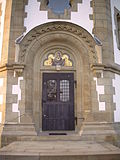Pilgrimage Chapel (Letzenberg)
The pilgrimage chapel “Seven Sorrows of Mary” has been located on the top of the 247 meter high Letzenberg in Malsch (near Wiesloch) in Baden since 1902 . It towers over the place by about 75 meters and is visible from afar on the south side of the mountain as a symbol of Malsch.
The foundation is made of hewn yellow sandstones which of Odenheim with horse-drawn carts were ramped up the mountain. The bricks placed over the octagonal floor plan came from Malsch's own quarries . The Pietà above the altar was specially made for the apse . A mosaic picture of the Sorrowful Mother of God was created by an Innsbruck sculptor (1903) around the portal . The stained glass windows with motifs from life Jesus come from foundations .
history
The first documented mentions of the Letzenberg as a place of pilgrimage show the year 1296. Around 1300 a chapel is said to have been located on the ridge of a documented estate.
On the southern slope of the mountain, then known as “Bletzenberg”, the oppressed farmers are said to have holed up during the final phase of the Peasant War . A chapel is not mentioned in 1525. On Wolf Reuss's wild card (1548), a "Wendelinus Chapel" is drawn in color in Bruch on the Electoral Palatinate- Bishop's territory south of Wiesloch . Around 1717 a Wendelinus chapel was once again mentioned in a document as a destination for the believers in the surrounding communities during field processions . In 1722 the Bishop of Speyer, Damian Hugo Philipp von Schönborn-Buchheim, allowed a collection for the building of a chapel " In honor of the Holy Cross on the Letzenberg ". However, the construction project was not started.
The Letzenberg pilgrimages begin in 1846 as a continuation of the Wendelinus procession that has taken place twice a year since "time immemorial" . The first way of the cross from the end of the village to the hilltop was created in 1883 from fourteen picture stations made of solid iron posts. The Way of the Cross was inaugurated on May 3, 1884.
The Mainz Bishop Paul Haffner issued an order to build a chapel in the 1888th Thanks to numerous foundations and collections from the parish of St. Juliana, the fund established for the construction of a chapel on the Letzenberg grew to 8,000 marks. In 1898, Pastor Engelbert Kaiser received permission from the building department of the Archbishop's Ordinariate Freiburg to build a simple chapel without an altar at the end of the Stations of the Cross. The given building plan was not approved by the parish and was not implemented. At the insistence of the pastor and the board of trustees, a new building plan was designed in an octagonal chapel ( octagon ) in the neo-Romanesque style , in a departure from the everyday construction . The original construction plans were submitted by the Archbishop's Building Office to the German Building Exhibition in Dresden in 1900 . Awarded a gold medal, however, they were lost.
In 1901, the excavation began , and the construction workers came across foundations, the presumable remains of the manors mentioned in a document around 1300 . Pastor Josef Isemann lays the foundation stone on May 4, 1902, with the inscription: " I was laid on the first Sunday in May 1902 " On Sunday, July 16, 1905, the tower bell with a weight of 429 pounds was consecrated. Sixteen years later, the chapel was painted in color in 1921.
On Good Friday evening (March 30th) 1945, the Letzenberg was under American artillery fire for the first time. Another shell attack on the Letzenberg took place on Easter Sunday without the chapel being hit. From 1975 to 1990 the chapel was completely renovated.
In 2009, the Archdiocese of Freiburg initiated the process of “geographical development” of pastoral care units. This included that the previously six legally independent parishes around the Letzenberg form a new joint parish or pastoral care unit from 2015 . The namesake of this new unit is the Letzenberg with the recognition symbol of the pilgrimage chapel, to which all six Catholic parishes ( Malsch , Malschenberg , Mühlhausen with Tairnbach , Rauenberg , Rettigheim and Rotenberg ) feel connected.
Pilgrimages
The spring pilgrimage takes place on the first Sunday in May and the autumn pilgrimage on the third Sunday in September. Between the two pilgrimages, there is a Eucharistic celebration on Tuesday evenings in the pilgrimage chapel. The horse pilgrimage takes place every year on the last Sunday in September . It ends after a devotion with the blessing of humans and animals.
Lookout point
On nice days there is a clear view of the Rhine plain and the Kraichgau .
Evening mood towards the west in the Rhine Valley
Web links
Coordinates: 49 ° 15 ' N , 8 ° 41' E







